Fox games are a category of asymmetric board games for two players, where one player is the fox and tries to eat the geese / sheep, and the opposing player directs the geese/sheep and attempts to trap the fox, or reach a destination on the board. In another variant, fox and hounds, the fox merely tries to evade the hounds. There are several versions known:
Permainan-Tabal is an Indonesian two-player abstract strategy board game. The game is sometimes referred to as a cross between alquerque and draughts. It is essentially draughts played on an expanded alquerque board. It is especially similar to draughts in that the moves of the pieces are strictly forward and sideways until they are promoted to kings by reaching the other player's first rank. The game is also referred to as dama.
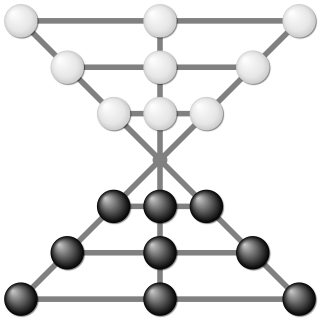
Lau kata kati is a two-player abstract strategy game from India, specifically from Lower Bengal, and also from United Provinces, Karwi Subdivision where it is called Kowwu Dunki, and it was described by H.J.R. Murray in A History of Board-Games Other Than Chess (1952). The game is related to draughts and even more so to Alquerque. Pieces are captured by leaping over them. The board is a pattern of two triangles joined together at a common vertex with further lines subdividing them. It is the same game as Butterfly (game) from Mozambique, which suggests a historical connection between the two games. Lau kata kati belongs to a specific category of games called Indian War-games, and the other games in this category are Dash-guti, Egara-guti, Pretwa, Gol-skuish. All Indian War-games have one important thing in common, and that is that all the pieces are laid out on the patterned board, with only one vacant point in the center. This forces the first move to be played on the central point, and captured by the other player's piece.
Dash-guti is a two-player abstract strategy board game from India, specifically from Central Provinces, United Provinces, Karwi Subdivision where it is called Kowwu Dunki which is the same name given to another similar game called Lau kata kati, and it was described by H.J.R. Murray in A History of Board-Games Other Than Chess (1952). The game is related to Draughts and even more so to Alquerque. Pieces are captured by leaping over them. Dash-guti consists of a Lau kata kati board, but with the addition of two line segments connected to the vertex but exterior to both triangles. Dash-guti belongs to a specific category of games called Indian War-games, and the other games in this category are Lau kata kati, Egara-guti, Pretwa, Gol-skuish. All Indian War-games have one important thing in common, and that is that all the pieces are laid out on the grid patterned board, with only one vacant point in the centre. This forces the first move to be played on the central point, and captured by the other player's piece.
Egara-guti is a two-player abstract strategy game from India, specifically from Central Provinces, and it was described by H.J.R. Murray in A History of Board-Games Other Than Chess (1952). The game is related to Draughts and even more so to Alquerque. Pieces are captured by leaping over them. Egara-Guti consists of a Lau kata kati board, but with the addition of two lines connecting the two triangles and running through them. Egara-guti belongs to a specific category of games called Indian War-games; some other games in this category are Lau kata kati, Dash-guti, Pretwa, Gol-skuish. All Indian War-games have one important thing in common, and that is that all the pieces are laid out on the grid patterned board in the beginning, with only one vacant point in the center. This forces the first move to be played on the central point, and captured by the other player's piece.

Pretwa is a two-player abstract strategy game from Bihar, India, and it was described by H.J.R. Murray in A History of Board-Games Other Than Chess (1952). The game is related to draughts and Alquerque as pieces are captured by leaping over them. The board is composed of three concentric circles divided by three diameters. Pretwa belongs to a category of games called Indian war games, which also includes the games Lau kata kati, Dash-guti, Egara-guti, Gol-skuish. All Indian war games have one important thing in common, and that is that all the pieces are laid out on the board at every intersection point, with the exception of the central point. This forces the first move to be played on the central point, and captured by the other player's piece.
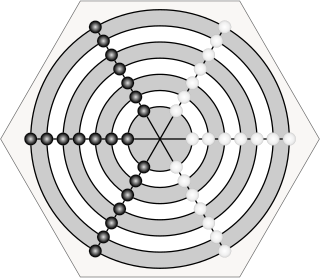
Gol-skuish is a two-player abstract strategy game from India, specifically from Central Provinces, and it was described by H.J.R. Murray in A History of Board-Games Other Than Chess (1952). The game belongs to the draughts and Alquerque family as pieces are captured by leaping over them. The board is composed of seven concentric circles divided by three diameters. Gol-skuish belongs to a specific category of games called Indian War-games which include Lau kata kati, Dash-guti, Egara-guti, and Pretwa. At the beginning of every Indian War-game all the pieces are laid out on the board at every intersection point, with the exception of the central point. This forces the first move of the game to be played on the central point, and captured by the second player's piece.
Rimau is a two-player abstract strategy board game from Malaysia. It is a hunt game, and specifically a tiger hunt game since it uses an expanded alquerque board. One tiger is being hunted by 24 men. The tiger attempts to eat the men, and the men attempt to trap the tiger. Unique to rimau, the tiger can capture a line of men in a single leap. There must be an odd number of men in the line, and they must be adjacent to one another. In most hunt games, the tiger, leopard, or fox is only able to capture one prey in a leap.

Buga-shadara, also known as Bouge Shodre, is a two-player abstract strategy board game from Tuva, a republic in Siberia, Russia. It is a hunt game where one player plays the deer. There are two deer usually represented as the black pieces. The boars are also referred black in the referenced article "Buga-shadara a folk game from Tuva". The other player has 24 white pieces with dogs associated to them. The board consist of an Alquerque board flanked on two of its opposite sides by a square patterned board. Because the board is in part an Alquerque board, this makes Buga-shadara a tiger hunt game. What makes Buga-shadara unique among tiger games are the expansion boards on the two opposite sides of the Alquerque board. They are square, whereas most are triangle-like. The word "shadara" resembles the word "shahdara". The "shah" part "is a title given to the emperors/kings and lords of Iran .". There is a place called Shahdara Bagh in Lahore, Punjab, Pakistan, and it's thought that the word "Shahdara can be translated as "the way of kings". Shah translates as "king" and dara translates as the way of kings." The referenced article associates the boars as kings. Perhaps the boars or deer are kings, and have to find a way or have a way with the white pieces or dogs.
Felli is a two-player abstract strategy board game from Morocco. It is related to Alquerque and draughts as pieces leap over one another to capture. Felli's closest relatives are several thousand miles away in the form of Lau kata kati from India and the game called Butterfly from Mozambique. One main difference is that the Felli board has only one horizontal line across its breadth as opposed to two found in the other two games.
Hat diviyan keliya is a two-player abstract strategy game from Sri Lanka. It is a Leopard hunt game. One tiger is going up against seven leopards. The leopards attempt to surround and trap the tiger while the tiger attempts to capture enough of them so that the leopards can not trap it.
Demala diviyan keliya or Koti Sellama is a two-player abstract strategy board game from Sri Lanka, formerly known as Ceylon. It is a hunt game, and since it uses a triangle board, Demala diviyan keliya is specifically a leopard hunt game. Three leopards are going up against fifteen dogs. The dogs attempt to surround and trap the leopards while the leopards attempt to capture enough of them in order to foil their objective. It is unknown how old the game is, but the game was described by H. Parker in his 1909 book Ancient Ceylon: An Account of the Aborigines and of Part of the Early Civilisation. The game is also known as the Tamil leopards' game. The game is well known in Southern India, and its Hindustani name is Rafāya.

Kharbaga is a two-player abstract strategy game from North Africa. In a way, it is a miniature version of Zamma; however, there are more diagonal lines per square on the board as compared to Zamma. The game is considered part of the Zamma family. The game is also similar to Alquerque and draughts. The board is essentially an Alquerque board with twice the number of diagonal lines or segments allowing for greater freedom of movement. The initial setup is also similar to Alquerque, where every space on the board is filled with each player's pieces except for the middle point of the board. Moreover, each player's pieces are also set up on each player's half of the board. The game specifically resembles draughts in that pieces must move in the forward directions until they are crowned "Mullah" which is the equivalent of the King in draughts. The Mullah can move in any direction.
Fetaix is a two-player abstract strategy board game from Morocco. It is very similar to Alquerque. The only difference is that pieces cannot move backwards until they are promoted to Mullah which is the equivalent of King in draughts. Furthermore, Mullahs can move any number of vacant points on the board, and capture enemy pieces from any distance similar to the Kings in International draughts. Another name for the game is qireq.
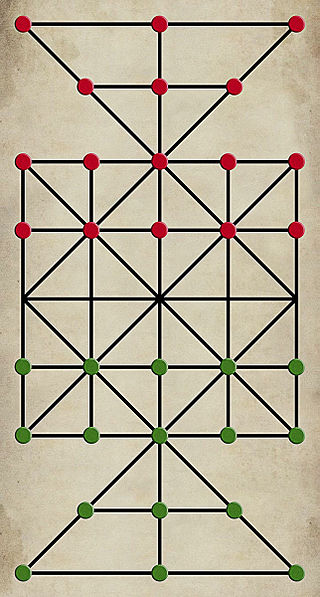
Sixteen soldiers is a two-player abstract strategy board game from Sri Lanka. It also comes from India under the name cows and leopards. A variant of this game is also popular in Bangladesh, where it is known as sholo guti. One way it is played, is by drawing the court of the game on the ground and using stones as pawns.
Kotu Ellima is a two-player abstract strategy board game from Sri Lanka played by the Sinhalese people. The game was documented by Henry Parker in Ancient Ceylon: An Account of the Aborigines and of Part of the Early Civilisation (1909); the game was printed as "Kotu Ellima" which is actually a misspelling because his source for the game was Leopold Ludovici's Journal of the Ceylon Branch of the Royal Asiatic Society (1873), and specifically in the chapter entitled "The Sports and Games of the Singhalese", and Ludovici wrote the name of the game as Kotu Ellime or Taking of the Castles. The game is similar to draughts (checkers) and Alquerque as players hop over one another's pieces to capture them; it is more similar to Alquerque between the two since it uses a standard Alquerque board. However, unlike draughts and standard Alquerque, the game is played on an expanded Alquerque board consisting of four triangular boards attached to the four sides of a standard Alquerque board. It closely resembles peralikatuma and sixteen soldiers which are also played in Sri Lanka and other parts of the Indian subcontinent with the only difference being the number of pieces. In sixteen soldiers, each player has 16 pieces hence the name of the game. In peralikatuma, each player has 23 pieces. In Kotu Ellima, each player has 24 pieces, and at the beginning of the game the whole board is covered with them except the central point reminiscent of standard alquerque.
Tûkvnanawöpi is a two-player abstract strategy board game played by the Hopi native American Indians of Arizona, United States. The game was traditionally played on a slab of stone, and the board pattern etched on it. Tukvnanawopi resembles draughts and Alquerque. Each player attempts to capture each other's pieces by hopping over them. It is unknown how old the game is; however, the game was published as early as 1907 in Stewart Culin's book "Games of the North American Indians Volume 2: Games of Skill".
Terhüchü is a two-player abstract strategy board game from Nagaland in Northeast India and is played by the Angami Naga ethnic group.
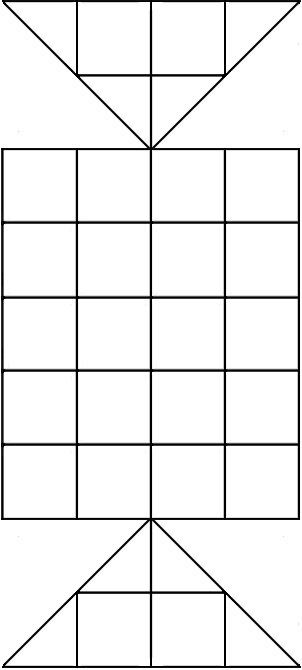
Astar is a two-player abstract strategy board game from Kyrgyzstan. It is a game similar to draughts and Alquerque as players hop over one another's pieces when capturing. However, unlike draughts and Alquerqe, Astar is played on 5×6 square grid with two triangular boards attached on two opposite sides of the grid. The board somewhat resembles those of kotu ellima, sixteen soldiers, and peralikatuma, all of which are games related to astar. However, these three games use an expanded alquerque board with a 5×5 square grid with diagonal lines. Astar uses a 5×6 grid with no diagonal lines.
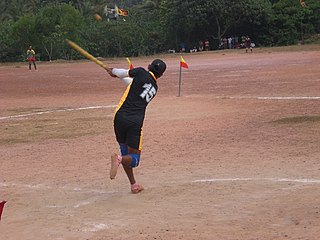
Sri Lanka has several traditional games and sports, many of which are played during the Aluth Avurudda festival. Some of these games are similar to other traditional South Asian games.








